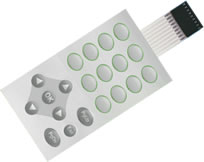
Electrical switches are an essential component used in electronic devices. Their primary purpose is to control a circuit using a basic “on” and “off” mechanism. When an electrical switch is turned on, the circuit is complete and thus powered. When it’s turned off, the circuit is closed and thus not powered. While mechanical switches are the most common, membrane switches have become a popular alternative for manufacturing companies because of their unique benefits.
#1) Low Profile
Because they are designed with printed circuits and a flexible substrate, membrane switches have a lower profile than other electrical switches. Their compact, slim design allows manufacturing companies to use them in remote controls, appliance buttons and other applications requiring a low-profile design.
#2) Easy to Clean
Membrane switches are also easy to clean, requiring little more than the occasional dusting using a lint-free cloth. The same can’t be said about mechanical switches. With mechanical switches, dirt and debris often becomes trapped underneath the buttons where it’s next-to-impossible to remove. Using canned air may blow out some of this dirt and debris, but the only way to fully clean a mechanical switch is to disassemble the buttons or keys.
#3) Water Resistant
Not only are they easy to clean, but membrane switches are resistant to water and other liquids as well. You can find membrane switches available in several Ingress Protection (IP) ratings that offer protection from the ingress of water and liquids. The smooth surface of a membrane switch means that water and liquids will roll off the side rather than entering the switch’s circuit. For outdoor applications where moisture is common, there’s no substitution for membrane switches.
#4) Tactile Feedback
Membrane switches can be designed to provide tactile feedback. Of course, tactile feedback refers to the physical sensation that’s created by an electrical switch, or device, in response to user action. Snap-style domes can be used in membrane switches that deform when pressed and snap back when release, thus creating tactile feedback.
#5) Backlighting
Backlighting is frequently added to membrane switches to improve its functionality by illuminating buttons and keys. There are several types of backlighting available for membrane switches, one of which is electroluminescent (EL). Using colored phosphor compounds, EL bulbs can illuminate the front of a membrane switch. A second type of backlighting for membrane switches is light-emitting diode (LED). When compared to EL bulbs, LED bulbs last longer and are more energy efficient. The only downside to using LED backlighting in a membrane switch is that it may create bright spots.
